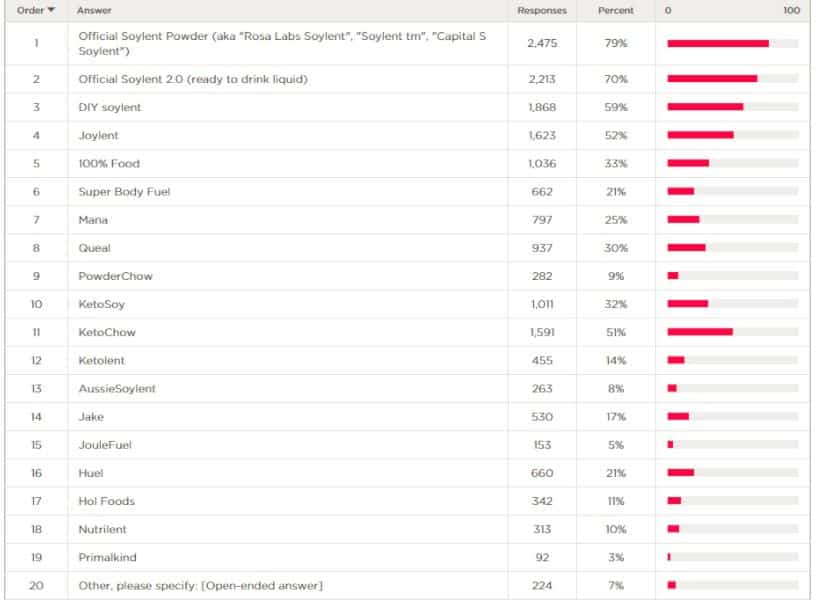Are Soylents the Foods of the Future?
Table of contents

If you are someone who is fortunate enough to have an “office job” that pays better than 99.99% of the jobs most people have to work around the globe, your daily life probably looks something like this. You drive to work in a car you only use 5% of the time, grab an overpriced coffee, sit in meetings with your annoying cow-orkers all morning, then type away at your TPS reports until it’s 2PM. By the time lunch comes around, you quickly grab something unhealthy and chomp away at your desk annoying everyone around you. When you’ve finished your eight-hour sentence, you arrive home late and order pizza. Our hard-working MBAs know this problem all too well, many of them suffering from malnutrition since they can’t afford to eat because we give away all their hard work for free.
Putting this first world problem aside, there is a much more important problem to solve. Currently, there are 815 million people in the world suffering from chronic hunger, even though there is more than enough food produced to feed everyone. Hidden hunger, caused by the lack of necessary vitamins and minerals in one’s diet, affects billions.

(Now, before we start bashing all those evil capitalists, let’s be sure to notice how prevalence is plummeting, so progress is indeed being made). Nutritionally complete foods, also called future foods or soylents (as a generic term, with a lowercase “s”), promise a cheap, quick and healthy alternative to traditional meals. These are typically powder-based or ready-made drinks that contain all the nutrients your body needs in exactly the right amounts.
The History of Soylents
The history of soylents is basically that they were featured in some science fiction novel (where most tech ideas originate) and then some guy named Rob Reinhart, the inventor of Soylent (the brand, with a capital “S”), decided to create the stuff for reals to get off his diet of ramen and kay-sa-dill-as. Then when the idea seemed to work, he created a community around it which generated the demand which led to an extremely successful crowdfunding campaign in 2013 in hopes that his product could alleviate world hunger. Not all was well though, as his claims were met with skepticism from nutritionists who advocated instead for a diverse, locally produced diet. While this may just be because this product kind of sidesteps the need for a nutritionist, even the skeptics agree that these meal replacements are helpful for hunger relief in case of emergency. They are already being used by anti-hunger organizations to alleviate micronutrient deficiency in disaster areas and treat acute malnourishment.
So What About the Planet, Man?
Not only are soylents cheap and easy to make, but they are also plant-based. This means they require less water and produce less CO2 than meat, making soylents as eco-friendly as synthetic foods and lab-grown meat. The livestock sector produces 40% of global agricultural GDP, occupies one-fourth of Earth’s land, uses one-third of its arable land for feed, and accounts for 18% of global greenhouse gas emissions in the process. Producing animal-based foodstuffs is also more energy-intensive than growing plants – not to mention the fact that plant-based foods don’t exploit the suffering of animals.

Future foods promise to at least mitigate, if not solve, these serious issues. That’s why when we heard about one company trying to solve these problems by creating a soylent, and said company had raised $50 million in fresh funding last year from Google Ventures, we just had to take a closer look.
About Soylent

5 years and 5 funding rounds later, Soylent’s vision has support from the likes of Y Combinator, Google Ventures, and Andreessen Horowitz. Even though Soylent’s market isn’t really thought of as health food supplements, it’s still worth noting that Euromonitor claims that global sales of health food reached $1 trillion last year. The total addressable market (TAM) is certainly large enough for some serious growth to take place.
Like anything worth doing, Soylent hasn’t been without trials and tribulations. Behind the scenes, they have been transparently tweaking the product formula since inception, similarly to IT startups trying out new code on beta testers. In October 2016, following reports that their nutrition bars, drink powders, and morning drinks were making some people sick, the company discontinued sales for a brief period of time to correct mistakes. They dropped the energy bar format and are now back to business development with a website subscription service and a coffee, vanilla, and chai flavored morning drink available in select 7-Eleven stores. They have maintained their website and Amazon presence, as well. In December 2017, Rhinehart concluded that Soylent was “no longer in early startup stage” and stepped down as CEO, handing the reins over to Bryan Crowley, a gentleman who has 20 years of experience in the food industry. That’s on the back of last year’s funding round which will be used to create new products, expand their retail presence, and enter into international markets which will probably involve some renaming (Pocari Sweat anyone)?
Other Soylents Out There
The hype around Soylent has encouraged people to experiment with DIY recipes and web communities are springing up around the sharing and rating of homemade alternatives. While this provides companies like Soylent with useful end-user feedback, it has also helped fuel competition in the space with new entrants offering different iterations. KetoChow, another well-known provider, treats its ketogenic recipe as open-source while selling packets to people who want to avoid the hassle of DIY and save time. (According to Wikipedia, “the ketogenic diet is a high-fat, adequate-protein, low-carbohydrate diet that in medicine is used primarily to treat difficult-to-control epilepsy in children“.)
Another Soylent competitor, KetoOne, puts out a cool “soylents survey”, the latest of which featured 9 producers of future foods and 3,157 consumers who answered various questions about this space. According to that survey, the global market for soylents in 2016 was estimated at $80-110 million, which translates into a 217% growth over the previous year. Results show consumers replace 1-2 meals a day with future food and that once they try, they stick with it. 88% would recommend it to others, which is not surprising given the fact 45% of users report improved health. There’s a need for diverse nutritional blends with weight-loss/low-carb/ketogenic products, organic/vegan/non-GMO variants, and muscle-building blends being the most sought-after with price being the most important factor:
Some newer private companies competing with Soylent surfaced in that survey, and some of the ones that stood out based on brand recognition were Jimmy Joy (The Meal-Replacement Formerly Known as Joylent), KetoChow, and KetoOne, established in 2014, 2015, and 2014 respectively, all of which have undisclosed funding. (100% Food, which also had brand recognition above 30%, has disappeared since then. Their products are listed on Amazon but are out of stock, and it closed down according to reddit.) Here’s the total list of companies they asked people about in the survey:
After DIY soylents and the original Soylent we see Jimmy Joy, incorporated in the UK and produced in the Netherlands, which is the European market leader of soylents. They offer both traditional and vegan formulas, sports shakes with extra energy, morning shakes with caffeine, and ready-to-eat bars. Their marketing, aimed at the younger generation, features colorful cartoon characters representing the flavors. At $1.12 a meal, it is one of the cheapest alternatives on the market.
Next most popular is the aforementioned KetoChow which serves the niche of people on a ketogenic diet. Founder Chris Bair created his soylent at home, as he couldn’t find a keto option on the market. His recipes are publicly available, and the company has grown from a one-man show in the Bair family kitchen to a 16-employee startup located in a warehouse in South Jordan, Utah shipping meals globally through their website and also on Amazon where they can be found for $3.14 per meal.
The company that did that survey, KetoOne (formerly Ketosoy), is another provider of ketogenic soylent which costs $2.62 a meal. The main difference here is that the powder base and the necessary oils are provided separately, making your meal preparation take about 3 seconds longer.
Most of us haven’t tried any of these soylent foods yet, but one of our MBAs has been drinking Jimmy Joy for the past 9 months and finds the meals are quick to prepare, filling, and help you avoid food comas. For anyone with the first-world problem of not having enough time to eat all the plentiful food around them, you’ll find that these food substitutes are significantly cheaper than cocaine and safer for you. Soylent fans may not agree, but it seems like there are loads of “meal replacement offerings” from established health food companies that aren’t startups like Ensure Nutrition Shakes, Atkins Shakes, or Vega One just to name just a few.
Conclusion
While capitalism continues to take a bite out of world hunger, these future foods might provide the easy and sustainable nutrition fix to the remaining hungry people in the world today. As we concluded in our article on recycling plastics with new technology, any technology that helps the world will only grow if it makes money – and there appears to be a lot of money to be made in future foods like these soylents.
If you want to try some of the original Soylent 100% vegan meal replacement, with carbohydrates from beets, protein from soy, healthy fats from renewable algae sources, just get out your wallet and pay Amazon like $39 for 12 bottles of it. Sort yourself out.
Sign up to our newsletter to get more of our great research delivered straight to your inbox!
Nanalyze Weekly includes useful insights written by our team of underpaid MBAs, research on new disruptive technology stocks flying under the radar, and summaries of our recent research. Always 100% free.





















